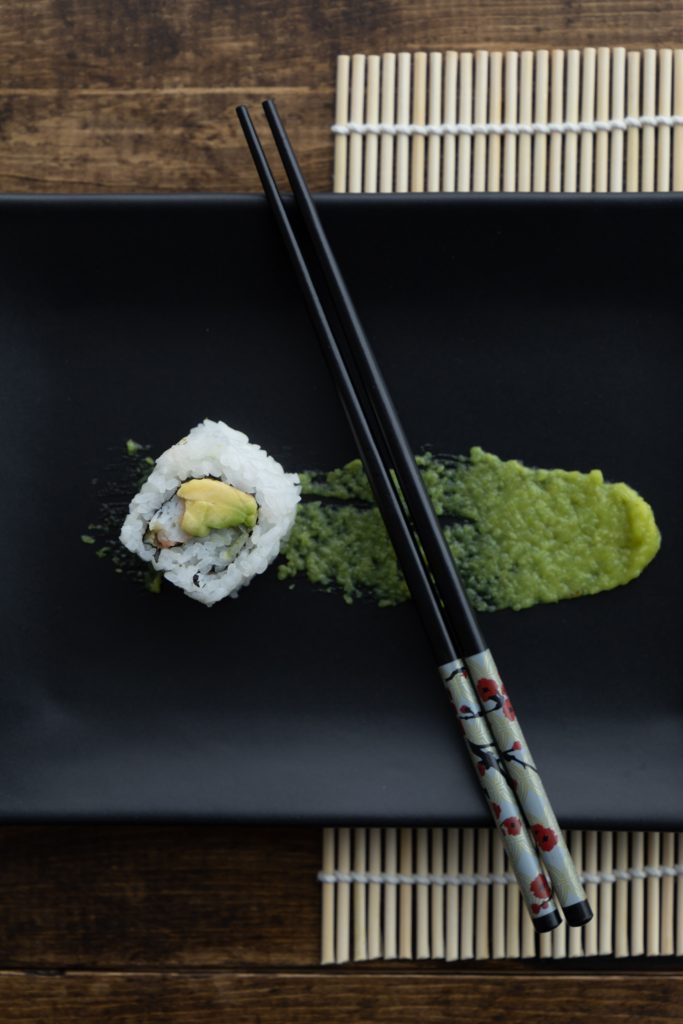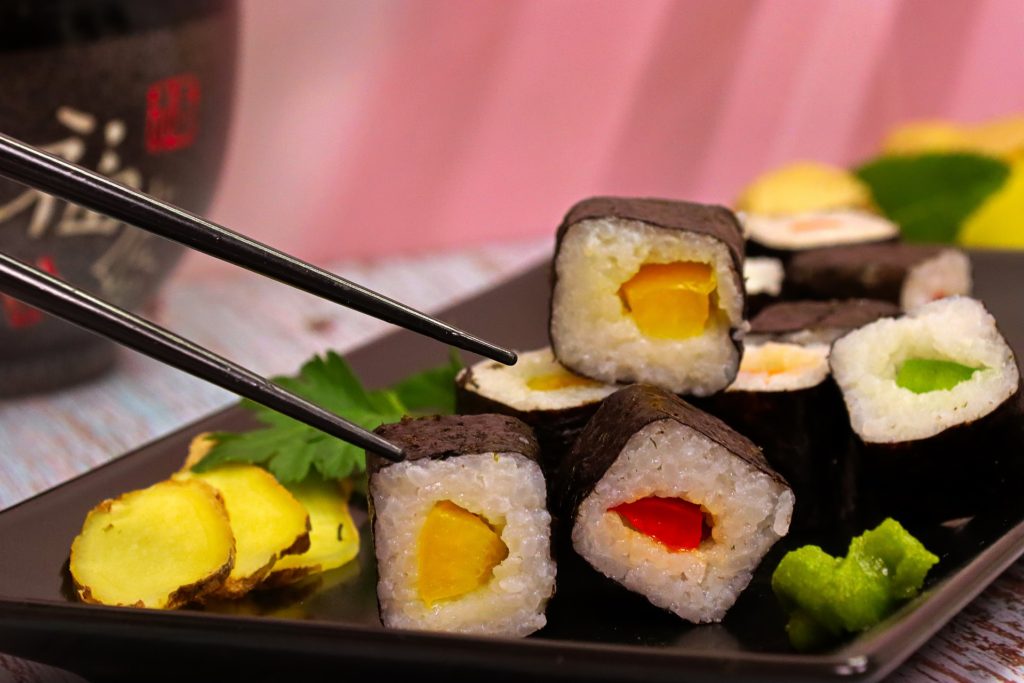Vegan Japanese Food
Vegan Japanese food is not as rare as one may think. In fact a lot of Japanese dishes are unintentionally vegan. In this particular article we have focused are attention on the vegan Japanese Hosomaki rolls. You actually maybe surprised to find out that your favourite vegan Japanese maki roll might not be as authentically Japanese as you thought. Have you ever tried a vegan hosomaki roll? What’s your favourite vegan Japanese food? If you’re looking for more vegan Japanese food ideas why not try the Caavakushi vegan search engine.
A significant proportion of the Japanese community is now going vegan. This is more common in the larger city’s such as Tokyo and Kyoto as more restaurants are starting to cater to vegan needs. Vegan sushi is now more readily available than ever before in Japan and around the world. Guess what, there’s actually an added bonus to eating vegan Japanese food. Well we all know how expensive going out for sushi can be and it’s mainly due to the cost of the meat used. Eating vegan Japanese food costs significantly less because the vegetables are a much cheaper ingredient than the meat. So it can really save you a lot of money in the long run if you’re an avid sushi eater.
Hosomaki
If your a fan of Japanese food you’ve probably eaten a few thin maki rolls in your day. They make the prefect snack and are normally severed as appetizers. The full name for this type of maki roll is hosomaki. Hosomaki is a distinctive type of sushi roll. The word ‘Hoso’ means thin in Japanese. ‘Maki’ translated from Japanese means roll. Therefore the key factor of this sushi roll is the maintenance of it’s thin stature. It’s also known to be cut into small pieces and consist of only one ingredient which is placed centrally.
Japanese Culinary Arts
For centuries Japanese people have been perfecting their traditional dishes. Becoming a sushi chef is no easy feat. It may take you between in 10 to 20 years to master this skill. This is because the core values of sushi making are based on precision.
We may have a not-so-secret, secret to reveal to you. It may come as quite a shock to most people that a lot of Japanese dishes are unwittingly vegan. Even some hosomaki rolls that you would find out your local Japanese restaurant.
Did you know that the most popular starters people pick in Japanese restaurants are hosomaki rolls? You may be surprised to know that they are derived from simple ingredients. It also doesn’t take a rocket scientist to make them. They’re actually very easy and quick to make. But getting it perfect is another story altogether. Even with years of practice you may never come close to replicating the work of a sushi chef who has spent years perfecting their craft.
Japanese Sticky Sushi Rice
One of the most important parts of the Japanese diet is rice. Japanese sushi rice should be carefully prepared in most dishes including hosomaki rolls as it is one of the main ingredients. You can use this Japanese sushi rice recipe for hosomaki rolls and other Japanese dishes.
In Japanese cooking proportions are everything. If you make a mistake with the ratio of each proportion your rice could end up tasting extremely salty or extremely sweet. Not to mention overcooked or undercooked. So make sure you stick to the recipe exactly as it is, for the best possible results.
Sushi Vinegar Recipe
Mix the following proportions into a glass jar with a lid.
9 tbsp Rice Vinegar
6 tbsp Sugar
1 tbsp Salt
Always maintain 9:6:1 proportion.
Shake thoroughly when the ingredients have all been added. Leave to stand.
You should prepare the sushi vinegar 24 hours before you make the sushi rice. This will allow enough time for the vinegar to mix and the solution to turn clear. You will know that the sushi vinegar is ready to be used when the jar isn’t cloudy and appears clear. You can store the access vinegar you make for a few months in a cool dry cupboard or pantry.

Vegan Japanese Sticky Sushi Rice Recipe
Utensils:
A large glass bowl
A medium pot with a glass lid
Wooden spoon with a diagonal cut head
Hand fan
Ingredients:
Japanese sushi rice
Water
Rice vinegar
Sugar
Salt
Sushi Rice Recipe
Cleaning the rice
Add a little bit of warm water to 1 cup of rice in a pot over the sink. To begin the process of cleaning the rice move your hands in a circular motion while gently moving your fingers through the rice grains. Then use a rice strainer to rinse off the water from the pot of rice. You will probably have to repeat this process until the water becomes somewhat clear. Use the rice strainer to drain the clear water and put the cleaned wet rice back into the pot.
Water
Add 1 cup of drinking water to the pot of rice. Then refill the cup to 10% full and add that extra bit of water to the cleaned rice in the pot. Place the lid firmly on the top of the pot.
Bring the water in the pot to a boil over high heat. Once the water is boiling you can reduce the heat to the lowest setting and leave to simmer for 15 minutes. Keep the lid on the entire time the rice is cooking. Turn off the heat and let the rice stand for 10 minutes with the lid kept on.
Mixing
Finally gently transfer the sushi rice into a large glass bowl using a wooden spoon with a diagonal cut head. Pour the sushi vinegar from the glass jar into the cup you used to measure the rice. You need a quarter of that cup of sushi vinegar. Pour it over the rice. Mix this gently into the rice using the wooden spoon. This can be done by diagonally cutting into the rice to avoid damaging the grains. Don’t forget to carefully turn over the rice from time to time. The glass bowls transparency helps us to see if the sushi vinegar is mixed correctly all over. At this point you should be fanning the rice with the hand fan to cool it down. The faster it cools the faster you can get to work on making your hosomaki rolls.
Kappa Hosomaki
Most non Japanese sushi lovers may have eaten this roll many times. But they probably only know it by its Western name. Did you know that kappamaki are known in the west as cucumber maki rolls?
Ingredients
Prepare the sushi rice earlier and leave to cool
Japanese Sushi Rice
Nori Seaweed Sheets
Cucumber
Sushi mat
Small bowl of water
Recipe
Step 1
You need to cut the nori sheets in half (so when cut in half they look like long rectangles not squares) as maki rolls are thin a whole sheet of nori is not required. The sheets should be lightly heated over a stove but not burnt.
Step 2
One long strip off cucumber should be cut to be placed in the middle of the maki roll.
Step 3
A (previously cut and heated) nori seaweed sheet should be placed on top of the bamboo sushi rolling mat.
Step 4
A thin layer of sushi rice should then be spread evenly over the nori sheet. A 1cm gap should be left along one of the long sides of the nori sheet. In order to seal shut the maki roll.
Step 5
Place the long sliced cucumber into the centre of the sushi rice. So it stretches the length of the nori sheet.
Step 6
Dip your finger into the bowl of water. Then run the wet finger across the the 1cm gap that you left on the nori sheet.
Step 7
You will have to work fast. The wet seal could dry up. It’s now time to roll the sushi. Make sure you hold down the cucumber with your fingertips and use your thumbs to pick up the mat and roll the contents into a tight thin roll. Fold over the 1cm wet section and press down with the mat to seal the roll.
Step 8
To cut the sushi roll take a sharp knife and wet it with water. The water helps to prevent the rice from sticking to the knife while cutting slices. When cutting you must not cut down. Instead cut forwards and then place the rest of the blade down. Make sure to cut each slice in this way. One roll should usually produce around 6 pieces.
If you find the taste too bland then we suggest dipping this rolls into some vegan mayonnaise to spice the flavour up a bit. If you want a more traditional taste why not try some traditional Japanese pink pickled gari sushi ginger.

Avocado Hosomaki
Did you know that avocado is not native to Japan? Traditional Japanese hosomaki recipes do not actually use avocado as an ingredient. This is because avocados have never been a staple in the Japanese diet. Nevertheless it has become a very popular hosomaki roll in the Western world.
Ingredients
Prepare the sushi rice earlier and leave to cool
Japanese Sushi Rice
Nori Seaweed Sheets
Avocado
Sushi mat
Small bowl of water
Recipe
Step 1
You need to cut the nori sheets in half (so when cut in half they look like long rectangles not squares) as maki rolls are thin a whole sheet of nori is not required. The sheets should be lightly heated over a stove but not burnt.
Step 2
One long strip off avocado should be cut to be placed in the middle of the maki roll.
Step 3
A (previously cut and heated) nori seaweed sheet should be placed on top of the bamboo sushi rolling mat.
Step 4
A thin layer of sushi rice should then be spread evenly over the nori sheet. A 1cm gap should be left along one of the long sides of the nori sheet. In order to seal shut the maki roll.
Step 5
Place the long sliced avocado into the centre of the sushi rice. So it stretches the length of the nori sheet.
Step 6
Dip your finger into the bowl of water. Then run the wet finger across the the 1cm gap that you left on the nori sheet.
Step 7
You will have to work fast. The wet seal could dry up. It’s now time to roll the sushi. Make sure you hold down the avocado with your fingertips and use your thumbs to pick up the mat and roll the contents into a tight thin roll. Fold over the 1cm wet section and press down with the mat to seal the roll.
Step 8
To cut the sushi roll take a sharp knife and wet it with water. The water helps to prevent the rice from sticking to the knife while cutting slices. When cutting you must not cut down. Instead cut forwards and then place the rest of the blade down. Make sure to cut each slice in this way. One roll should usually produce around 6 pieces.
The taste of these maki rolls is enhanced by dipping it in regular soy sauce.

Beetroot Hosomaki
Most hosomaki rolls are savoury in taste so we wanted to change things up a bit. We wanted to bring a splash of sweetness to our hosomaki rolls. Trying different fruits and vegetables was the fun part. Deciding upon a unanimous winner was a little harder. There were just so many great ingredients to choose from. But in the end we decided to add a pop of colour and sweetness to our hosomaki pallet with the help of beetroot.
Ingredients
Prepare the sushi rice earlier and leave to cool
Japanese Sushi Rice
Nori Seaweed Sheets
Beetroot
Sushi mat
Small bowl of water
Recipe
Step 1
You need to cut the nori sheets in half (so when cut in half they look like long rectangles not squares) as maki rolls are thin a whole sheet of nori is not required. The sheets should be lightly heated over a stove but not burnt.
Step 2
One long strip off beetroot should be cut to be placed in the middle of the maki roll.
Step 3
A (previously cut and heated) nori seaweed sheet should be placed on top of the bamboo sushi rolling mat.
Step 4
A thin layer of sushi rice should then be spread evenly over the nori sheet. A 1cm gap should be left along one of the long sides of the nori sheet. In order to seal shut the maki roll.
Step 5
Place the long sliced beetroot into the centre of the sushi rice. So it stretches the length of the nori sheet.
Step 6
Dip your finger into the bowl of water. Then run the wet finger across the the 1cm gap that you left on the nori sheet.
Step 7
You will have to work fast. The wet seal could dry up. It’s now time to roll the sushi. Make sure you hold down the beetroot with your fingertips and use your thumbs to pick up the mat and roll the contents into a tight thin roll. Fold over the 1cm wet section and press down with the mat to seal the roll.
Step 8
To cut the sushi roll take a sharp knife and wet it with water. The water helps to prevent the rice from sticking to the knife while cutting slices. When cutting you must not cut down. Instead cut forwards and then place the rest of the blade down. Make sure to cut each slice in this way. One roll should usually produce around 6 pieces.
Adding a dash of salty soy sauce may just complement this sweet hosomaki roll.

Pumpkin Hosomaki
This ingredient might seem a bit different. But it sure does taste delicious. In fact it’s something that we concocted ourselves at Caavakushi headquarters. We wanted to find an unusual yet tasty ingredient to add to our hosomaki rolls. The pumpkin definitely encompassed both the sweet and savoury taste. It also ended up exceeding all our expectations.
Ingredients
Prepare the sushi rice earlier and leave to cool
Japanese Sushi Rice
Nori Seaweed Sheets
Pumpkin
Sushi mat
Small bowl of water
Recipe
Step 1
You need to cut the nori sheets in half (so when cut in half they look like long rectangles not squares) as maki rolls are thin a whole sheet of nori is not required. The sheets should be lightly heated over a stove but not burnt.
Step 2
One long strip off pumpkin should be cut to be placed in the middle of the maki roll.
Step 3
A (previously cut and heated) nori seaweed sheet should be placed on top of the bamboo sushi rolling mat.
Step 4
A thin layer of sushi rice should then be spread evenly over the nori sheet. A 1cm gap should be left along one of the long sides of the nori sheet. In order to seal shut the maki roll.
Step 5
Place the long sliced pumpkin into the centre of the sushi rice. So it stretches the length of the nori sheet.
Step 6
Dip your finger into the bowl of water. Then run the wet finger across the the 1cm gap that you left on the nori sheet.
Step 7
You will have to work fast. The wet seal could dry up. It’s now time to roll the sushi. Make sure you hold down the pumpkin with your fingertips and use your thumbs to pick up the mat and roll the contents into a tight thin roll. Fold over the 1cm wet section and press down with the mat to seal the roll.
Step 8
To cut the sushi roll take a sharp knife and wet it with water. The water helps to prevent the rice from sticking to the knife while cutting slices. When cutting you must not cut down. Instead cut forwards and then place the rest of the blade down. Make sure to cut each slice in this way. One roll should usually produce around 6 pieces.
Have you ever tried vegan pumpkin hosomaki? What did you think of the flavour?
We would love to hear your thoughts. If you’re trying pumpkin hosomaki rolls for the first time we have a few tips to share. We found that dipping the roll in vegan friendly soy sauce with reduced salt gives the maki roll an extra kick of flavour. If you’re feeling adventurous you can always try dipping the roll into some spicy wasabi.

Thoughts
All the vegan hosomaki recipes we mentioned are easy to make with a little bit of preparation. Which vegan hosomaki recipe did you like the best?
You can find all the ingredients you need to make your very own vegan hosomaki at home using the Caavakushi vegan search engine.
We’d love to see your renditions of these four delicious Hosomaki recipes. If you’re experimenting with any of these dishes in the kitchen take a snapshot and tag us on instagram. We’ll be featuring some of our favourite tagged posts on the Caavakushi instagram feed and stories.



